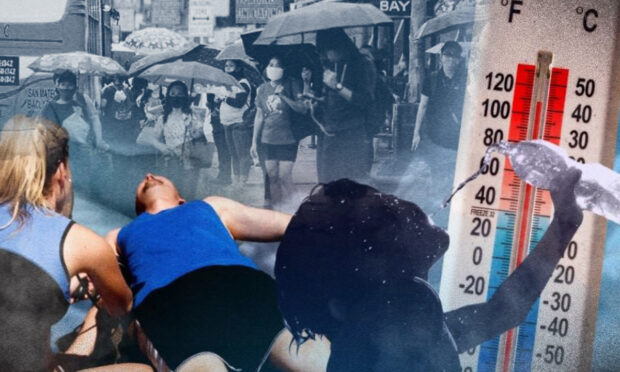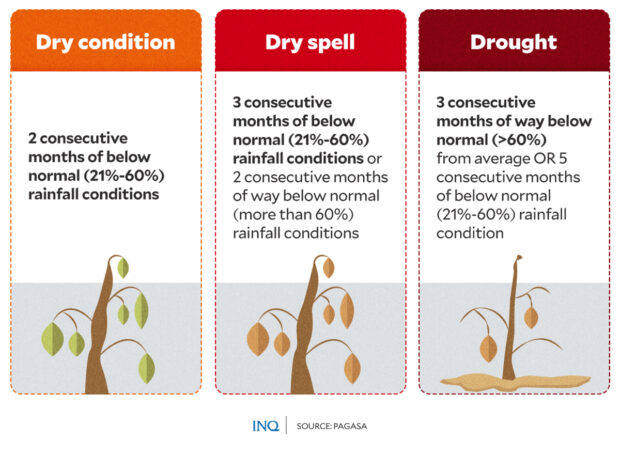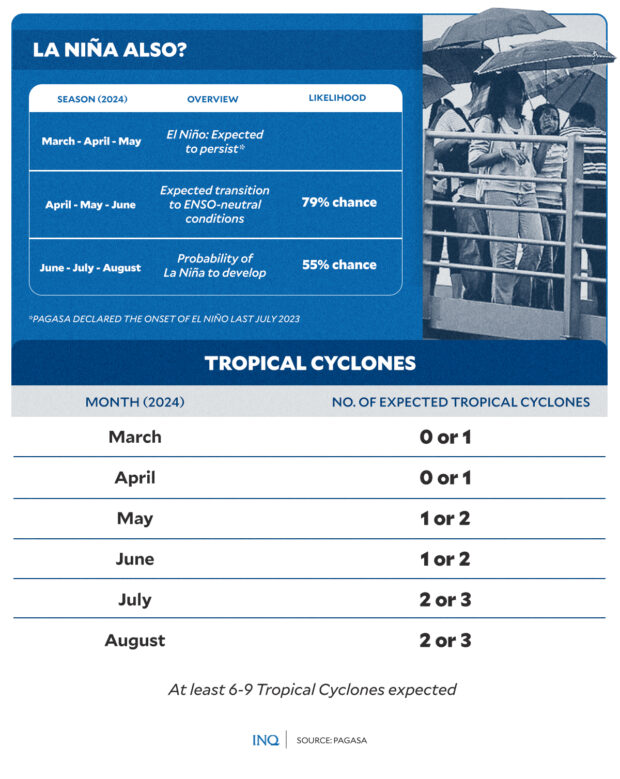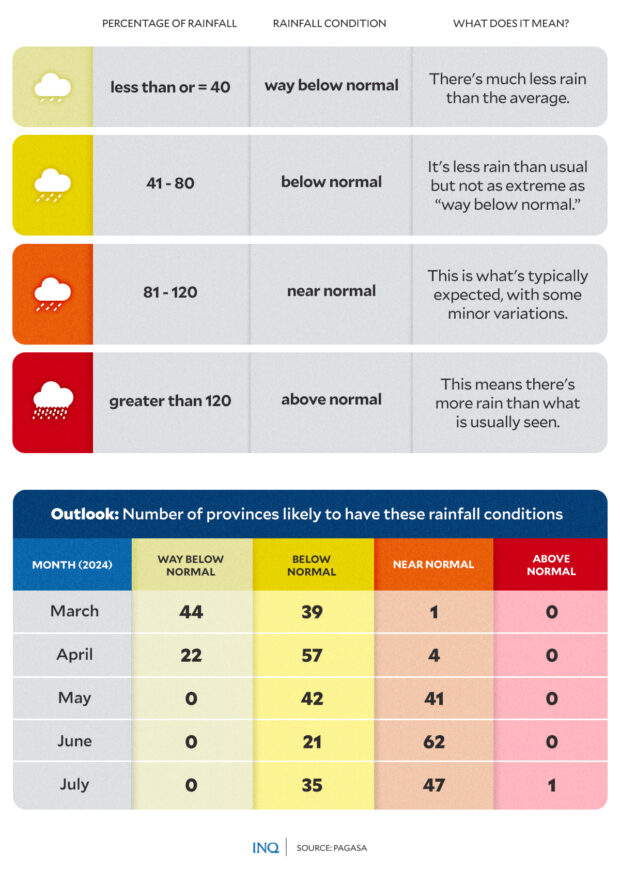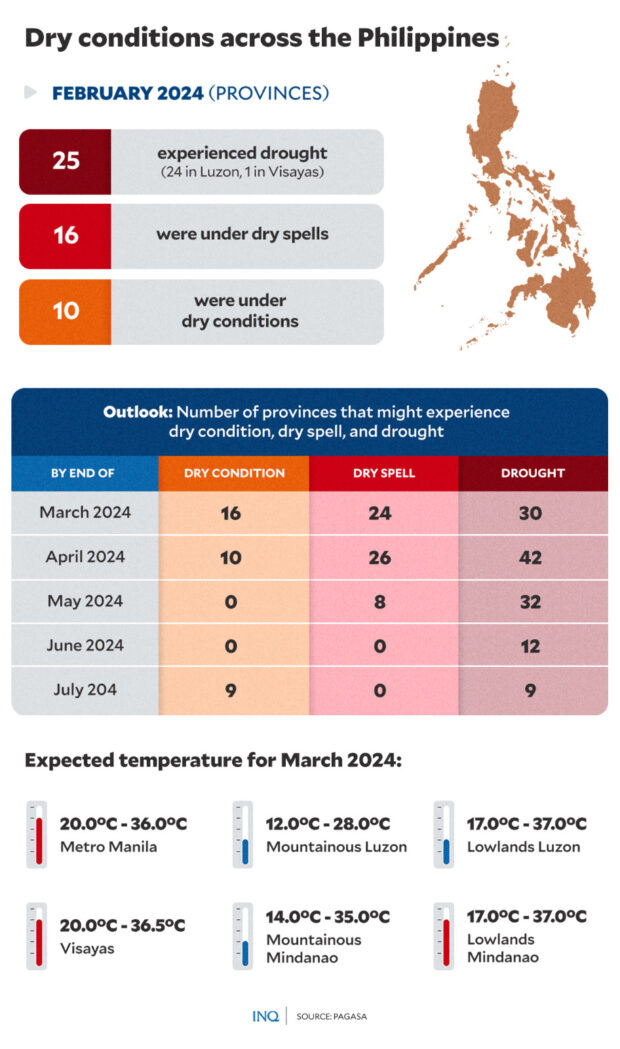El Niño, La Niña together? What to know
MANILA, Philippines — As the country grapples with high levels of heat brought by the El Niño phenomenon, the state weather bureau simultaneously issued an advisory for El Niño’s opposite, La Niña.
Confused?
This advisory for La Niña, characterized by elevated amounts of rainfall, comes even as many parts of the country feel the effects of El Niño, characterized mainly by extreme heat and dry conditions.
This drew questions about what these concurrent announcements mean for the country’s weather in the months ahead.
Warm and dry weather will persist, but…
According to the Philippine Atmospheric, Geophysical, and Astronomical Services Administration (Pagasa), the country has been in the grip of El Niño since July 2023.
Article continues after this advertisementThe advisory issued by Pagasa that month officially signaled the onset of increased heat and reduced rainfall.
Article continues after this advertisementIn an El Niño update, Pagasa maintained that heat and dryness will prevail this month, also predicting that most of the country will have significant rainfall decline that is lower than usual.
Pagasa said that by the end of March, at least 15 provinces were projected to have dry conditions, 22 with dry spells and 30 with drought.
READ: Pagasa raises La Niña Watch as forecasts show early onset
Pagasa also projected higher air and surface temperatures nationwide, which could range from 20.0°C to 36.0°C in the country’s economic capital Metro Manila.
But in the same advisory, Pagasa also officially started a La Niña Watch to warn about the emergence of extremely wet conditions in the coming months.
La Niña watch: What is it?
According to the Pagasa advisory, while El Niño is showing signs of weakening, it was expected to continue through March, April, and May, after which the weather is forecast to transition to what Pagasa said was Enso, or El Niño Southern Oscillation–neutral conditions in April and June.
The US National Oceanic and Atmospheric Administration (NOAA) described Enso-neutral as a phase in which neither El Niño nor La Niña is present, characterized by average sea surface temperatures in the Pacific Ocean, resulting in more normal weather patterns globally.
However, Pagasa also projected a 55 percent chance of La Niña making its presence felt in June, July, and August. It elevated the Enso alert and warning system to a La Niña watch.
La Niña, according to NOAA, is the opposite of El Niño, where the Pacific region cools down and impacts global weather conditions.
Ana Liza Solis, officer-in-charge of Pagasa’s Climatology and Agrometeorology Division, said that although “we have strong El Niño and we’re experiencing its impacts, we still need to issue La Niña watch.”
Delayed rainy season
According to Pagasa, you know it’s La Niña when there are colder temperatures, stronger winds from the east, and more clouds over the Philippines. Among its impacts include strong monsoon activity, more tropical cyclones, and above-normal rainfall.
However, following the issuance of La Niña Watch, the state weather bureau stressed that historically, La Niña’s early stages are characterized by below-normal rainfall even at the onset of the monsoon, or habagat, season.
Solis said in April, May, and June last year, the country experienced below-normal rainfall consistent with historical trends associated with La Niña.
She said historically, during La Niña, rainfall levels rise in the last quarter of the La Niña year.
She said it remained possible for the country to have below normal rainfall conditions that appear to be inconsistent with La Niña.
“There’s a possibility that, although some models predict near-normal rainfall conditions, the chance of experiencing lower-than-usual rainfall remains,” Solis continued.
She also noted that despite the weakening of El Niño, its significant effects are expected to be felt in March, April, and May.
Pagasa said the combined effects of El Niño and the initial stages of La Niña could delay the start of the rainy season, which typically comes in May and June.
For now, prepare for El Niño
“The message we want to convey is that, even though we’ve issued a La Niña Watch, our focus should still remain on the impacts of the strong El Niño,” Solis said.
She said the issuance of La Niña Watch “doesn’t mean we’re discussing the potential impacts of La Niña yet as it’s still far off and uncertain.”
READ: El Niño in PH: On top of killer heat, water scarcity looms
READ: Extreme heat in PH: Health risks, economic impact
READ: Extreme heat in PH: Health risks, economic impact
READ: El Niño waning, La Niña to develop in second half of 2024
Pagasa’s six-month rainfall outlook indicates that most regions in the country are likely to experience significantly below to below-normal rainfall conditions in March and April. It said many provinces were expected to see drought extend until May.
Solis also projected high temperatures from end of May to June. Pagasa had said this could lead to diminished water supply and higher water costs.
The extreme heat associated with El Niño is also linked to a rise in cases of tropical, pulmonary, and food- and waterborne diseases nationwide.
Other common potential health risks of El Niño include:
- increased heat-related illnesses: heat cramps, heat exhaustion, and heat stroke
- increased vulnerability of those with chronic conditions such as heart disease, mental conditions, and poor blood circulation
